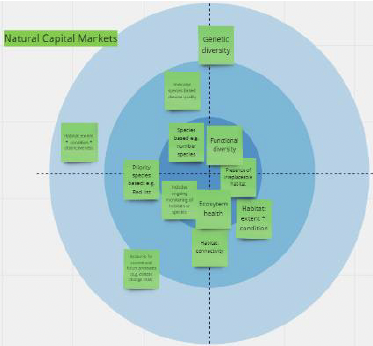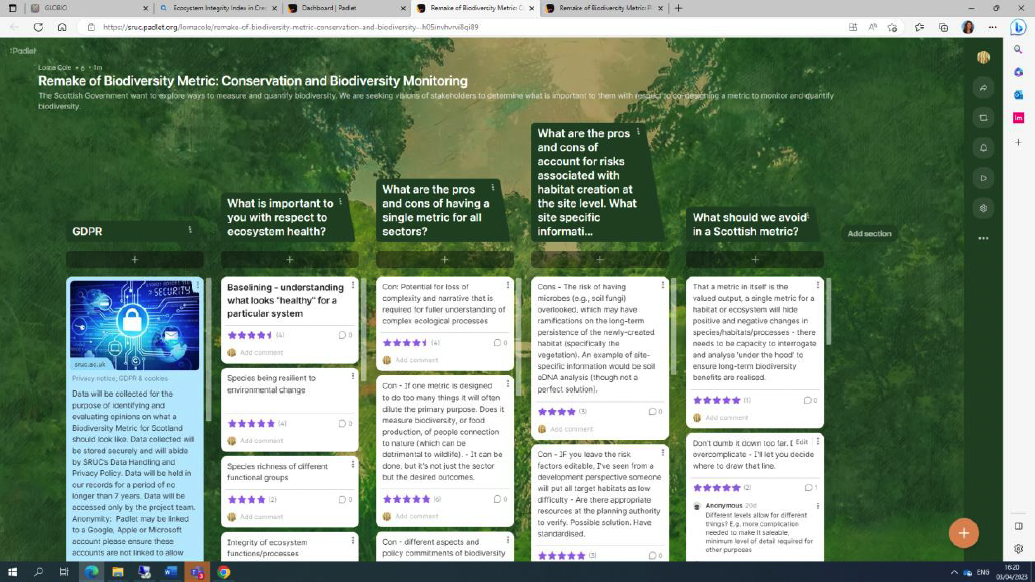Measuring biodiversity: research into approaches
This report considers methodologies for measuring biodiversity at site-level for use in Scotland.
Methodology
Assessment of criteria
Our first step was to identify a definitive list of criteria to evaluate a range of biodiversity metrics. Stakeholder workshops were held to prioritise and refine potential criteria for four key policy areas specifically: Agriculture, Conservation and Biodiversity Monitoring, Natural Capital Markets and Planning and Development. This ensured that the resultant assessment criteria were meaningful and deemed important across sectors.
We identified a range of potential criteria from the invitation to tender, our project proposal and additional sources such as the EU Business @ Biodiversity platform[2] (Table 1; Annex 1; Annex 2). Two online workshops were held to evaluate and prioritise criteria. The first workshop enaged with members of the project steering group (Scottish Government and NatureScot) and the second expanded to 72 stakeholders. Both workshops included representatives from the four identified policy areas.
Participants prioritised criteria using an online interactive Miro board[3]. 'Sticky notes' for each criterion were placed in different sectors of a 'target' where the inner-most ring represented the highest priority (Figure 2). In the initial steering group workshop, the 'target' was divided into four quadrants relating to policy area (i.e. Agriculture, Conservation and Biodiversity Monitoring, Natural Capital Markets and Planning and Development). In the subsequent, larger, stakeholder workshop the participants were first divided into breakout rooms based on policy interest. Separate 'targets' were then used for each breakout room to allow for more accurate placement. In both workshops there was the option to add further criteria where omissions were identified.

| Category |
Criteria |
Assessment questions (Responses may be yes/no or short text) |
Further comments |
|---|---|---|---|
| Habitats and species |
Habitat extent |
How is habitat extent included (e.g., extent only or extent/condition/significance)? |
Short description of condition and significance scoring |
| Habitat connectivity |
Is habitat connectivity included? |
Short description of method or data used |
|
| Habitat: priority or irreplaceable habitats |
Are priority habitats and / or irreplaceable habitats identified? |
How does the metric deal with priority or irreplaceable habitats, e.g. would scoring preclude development? |
|
| Ecosystem health and function |
How is ecosystem function and health included? |
Short description of method or data used |
|
| Ecosystem functional diversity |
Is the range of species types and traits measured? |
Short description of method or data used |
|
| Species |
Describe how species are included (e.g., indicator species, priority species, numbers) |
List of taxa included in species measurement |
|
| Ongoing monitoring |
Does the metric require future monitoring of outcomes? |
Short description of required monitoring activities and/or data |
|
| Current and future pressures (e.g., climate change risks) |
Does the metric allow for future risks (e.g., buffering of biodiversity units) |
What is the buffering margin? |
|
| Effort and ease of use |
Open access |
Are all data and methods open access? |
Short description of any proprietary data or methods used |
| Scalable: financial |
Are there financial implications for? larger scale applications? |
For example, would extensive field data collection be necessary? |
|
| Scalable: spatial |
Can the metric be applied over multiple spatial scales? |
||
| Expertise |
What level of expertise is required? |
Short description of where expertise is required, e.g., overall tool use, condition assessments etc. |
|
| Time requirements |
What is the indicative time needed to apply the metric? |
Examples from previous applications |
|
| Cost of use |
What is the indicative cost needed to apply the metric? |
Examples from previous applications, also linked to expertise, i.e., are costs internal or external? |
|
| Useability and comparability |
Clear, concise, transparent |
Can users determine how units or scores have been estimated? |
Short description of calculation method and outcome |
| Scientifically robust: measurable |
Is the metric related to a robust measure of biodiversity or ecosystem function? |
Short description of underlying approach (e.g., habitat condition assessment) |
|
| Alignment: current or future policy objectives |
Could the metric be used to inform progress towards policy objectives? |
||
| Alignment: current or future monitoring |
Could the metric be used to inform or be informed by current monitoring? |
Linked to ongoing monitoring above, can existing data be used to inform the metric? |
|
| Tradeable (or saleable) |
Is the metric designed to produce a tradeable unit (e.g., credit or token)? |
Tradeable - changes in one habitat can be compared to and traded for changes in another (i.e., offsetting or net gain) Saleable - measurable biodiversity units are created enabling commercialisation |
|
| Replicable |
Can the metric estimation be replicated across similar contexts? |
||
| Comparable across habitats and sectors |
Is common unit or score calculated? |
||
| Meaningful to all stakeholders |
What does the estimated unit or score represent? |
||
| Maturity |
Is the metric in use or under development? |
As a large number of criteria were identified, we divided the prioritisation task into three more manageable exercises that each considered a subset of criteria:
- Habitats and species metrics: this considered what is measured and how.
- Effort and ease of use: this considered the resource requirements for the metrics.
- Useability and comparability: this covered a range of criteria around robustness, transparency and comparability.
In interpreting the results, criteria were sorted into three categories (high, medium and low priority) based on their relative placement on the boards rather than absolute positions. This assessment was used to identify a definitive list of criteria (Table 1) which was then used to assess a total of 26 biodiversity tools and metrics.
Many of the criteria were qualitative and they could be interpreted in different ways. Annex 2 provides a summary of the criteria interpretation reflecting discussions held during the workshops.
Review of current tools
A total of 26 biodiversity tools and metrics were reviewed against the identified criteria (Annex 4). The review was light touch and based on publicly available details from organisational websites and published documents. The majority of the tools were developed to allow businesses to assess the impacts of their operations on biodiversity. This included lifecycle and supply chain analysis, and sector specific applications for agriculture and mining. We take a broad definition of what a 'metric' is, this could include single measures or indicators, or a more complex calculation to derive a measure of biodiversity. This reflects the inherent complexity and multiple aspects of biodiversity, the importance of which will vary across end-users and policy sectors.
Review of Biodiversity Metric 3.1
We conducted an in-depth review of Natural England's tool for quantifying Biodiversity - Biodiversity Metric 3.1. This tool was developed primarily for use in the Planning and Development sector. It calculates biodiversity on a proposed development site, calcuates losses tthrough development/activity and allows developers to explore different outcomes to mitigate loss (both on site and offsite). Here we explored the guidance and technical notes alongside references within these documents. Functionality was tested using several land use change scenarios. To assess its fitness for use in Scotland we explored the availability and appropriateness of data that underpins the metric, potential habitat classifications, and accompanying guidance. Consideration was given to applicability of use in different sectors (i.e. Planning and Development, Natural Capital, Biodiversity and Conservation and Agriculture) and alignment with existing or forthcoming biodiversity assessments. Discussions were held with representatives from industry and planning regulations with experience of using the tool in Scotland.
Sense checking workshop
Following the completion of the assessments a final sense checking workshop was held to gain further stakeholder insights. A total of 59 participants, including the project steering group, attended this workshop. Stakeholders again included all four sectors. Stakeholders were first provided with an overview of the findings to date. Stakeholders were then asked to join one of four breakout rooms based on their policy interest. To prompt discussion stakeholders were presented with a series of Microsoft Teams polls to identify preferences and an online ideas board using the Padlet[4] platform (Figure 2).

Contact
Email: katherine.pollard@gov.scot
There is a problem
Thanks for your feedback